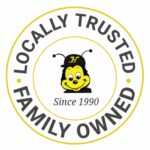Hoffman’s Exterminating reminds families that ants are more than a nuisance pest.
While homeowners across the country enjoy the warm weather and the sights, smells and activities of the season, they also must contend with increased pest activity. This season, Hoffman’s Exterminating is reminding homeowners to be on the look out for one of the most prevalent pest – ants.
Often considered the No. 1 nuisance pest, ants also pose significant health and property risk as they destroy wood and contaminate food items. And with more than 700 types of ant species in the United States, it’s not surprising that ants can quickly become a source of disgust, frustration and concern for homeowners.
“Most ants thrive in warm and moist conditions, which is why its best to eliminate moisture or standing water near or inside the home,” says William T. Hoffman, President & CEO of Hoffman’s Exterminating. “In some cases, the only way to completely remediate an ant infestation is to call a qualified pest professional who can locate and remove the identified species’ nests.”
The National Pest Management Association (NPMA) reminds homeowners that the first step to remediation is to properly identify which ant species is present in the home.
Some of the most common home invaders include:
- Odorous House Ants: These ants get their name from the unpleasant odor they give off when crushed, often described as smelling like a rotten coconut. They typically nest in wall voids and crevices and prefer sweet foods.
- Pharaoh Ants: Pharaoh ants prefer sweets, but also consume grease and even shoe polish. They live in extremely large colonies and keep warm near artificial heating sources like baseboard heaters and ovens.
- Carpenter Ants: This species hollows out nests in both dry and moist wood, though they prefer the latter. They can be particularly hard to remove since their nests can be more difficult to locate.
- Fire Ants: Fire ants can cause severe allergic reactions in addition to structural damage caused by chewing through the insulation around electrical wiring.
Homeowners who suspect an ant infestation should contact a licensed pest professional who can identify ant species and recommend a course of treatment. To learn more about ants, please visit the Hoffman’s website.



